Mortlake to Putney
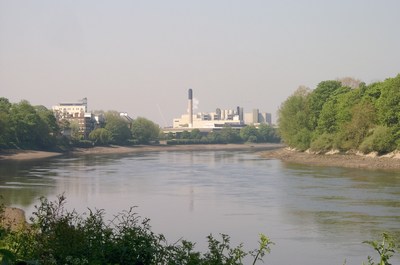 Thames Upstream of Mortlake
Thames Upstream of Mortlake
Mortlake brewery may be a noted landmark along the boat race course, but there is little else to merit this next section of towpath. It is narrow, muddy, poorly maintained, and somewhat claustrophobic, with a high brick wall almost literally rubbing my shoulder as I walk. The wall is part of the old brewery and is the subject of a preservation order, though goodness knows why. Ugliness is not a virtue.
A hundred years ago over 1400 workers made this brewery the largest employer in the area and the riverbank would be teeming with barges loading the barrels for distribution around the capital.
Modernisation and changes in distribution methods have reduced this greatly, and the river is no longer used for distribution. The brewery is now much smaller and owned by Stag Breweries.
The bridges are now coming thick and fast as I draw nearer to the centre of London. Hammersmith Bridge is a suspension bridge which I always think gives a sense of grandeur over the standard span bridges.
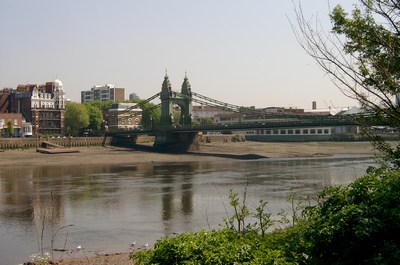 Hammersmith Bridge
Hammersmith Bridge
The first bridge over the river here was designed by our old friend William Tierney Clark who, if you recall, later designed Marlow Bridge. Clark built the very first suspension bridge over the river here in 1827. Traffic over the bridge was very heavy, and it was not many years before there were serious concerns about the strength of the bridge. Things came to a head with the 1870 boat race. The bridge is a splendid vantage point and is situated about halfway along the course. An estimated 12,000 people crowded on to the bridge that year to watch the race, and the local “health and safety” had a fit. Eventually, in 1884, a new bridge was designed by Sir Joseph Bazalgette (1818 – 1891) using the original supporting pillars. The bridge was opened in 1887.
Traffic continued to increase and Hammersmith suffered from more problems over the years. The bridge was completely refurbished in 1973, but additional replacement work was required in 1984 and 1987 to cope with the battering that the shear volume of traffic was giving the structure. In 1997 it was closed for over a year for more structural work and only opened again after the imposition of a weight restriction. The bridge was the target of a terrorist attack in 2000. After this the bridge was completely repainted in the style of the 1887 bridge and looks very well for it as I pass by.
Another boat race landmark appears, the Harrods Depository. The famous store in Knightsbridge no longer uses the premises, but the landmark façade is still preserved. The depository site is now a modern housing development.
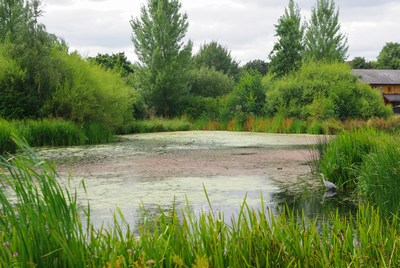 London Wetland Centre
London Wetland Centre
It is an amazing project. Put simply, the Wildlife and Wetlands Trust have taken the old Barn Elms Reservoirs and transformed them into a wildlife haven. In practice it must have involved a tremendous amount of hard work and landscaping. The Trust was founded in 1946 by Sir Peter Scott and currently owns nine wetland centres around the UK. When you consider that over half of the world’s natural wetland areas have disappeared during the last hundred years it seems even more amazing that this area of London has been turned back into a wetland and the wildlife has chosen to come to it.
The total area of the London site is 43 hectares, and has nearly two miles of footpaths to enable the visitor to easily access the different parts. There are several “hides” to avoid visitors accidentally frightening away the inhabitants and smaller ponds enable the visitor to get extremely close to some of the birds.
The reserve turned all of the previous theories about wildlife on its head. Instead of preserving the natural habitat and encouraging visitors to travel to the site this project created an entirely new artificial habitat for the wildlife close to where the people lived, and then waited for the birds to find it.
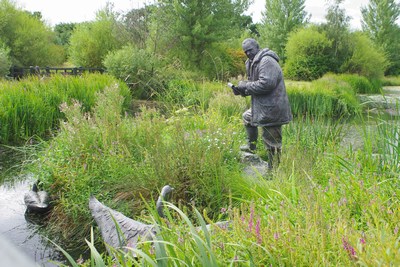 Thames Upstream of Mortlake
Thames Upstream of Mortlake
The Barnes Elms Reservoirs became redundant when the Thames Water ring main came into service. The Wildfowl and Wetlands Trust (WWT) approached Thames Water with a view to converting the reservoirs into a wetland and with the assistance of developer Berkeley Homes they came to an agreement and work began in 1995.The reservoirs were drained, leaving some water still for the current wildlife. Then the concrete retaining walls were demolished. The concrete was crushed and recycled as foundation materials and pathways. Smaller pools were sculpted into the landscape, all connected by a series of sluice gates that enable delicate control of the water levels.
After two years of landscaping and engineering it was time to start the planting. More than 300,000 aquatic plants, over 2,500 trees and hundreds of water-meadow flowers were planted. Our old friend from North Meadow, the Snakeshead Fritillary, has been successfully planted here and gives a fine display in late spring. Appropriately enough this area of the reserve has been named “Cricklade Fritillary Meadow”.
The theory of the city wetland centre was instantly proved to be correct. Wildlife literally flocked to the site, and rapidly established the habitat. There are now over 180 different species of bird, nine species of bats, more than 500 species of butterflies and moths and countless other insects that can be seen at various times of the year. Add a few reptiles and small mammals to this and you can see what a wonderful haven this has become in a very short time.
On the opposite bank sits Craven Cottage, the home of Fulham Football Club. The stadium has a capacity of 26,000 and Fulham first moved here in 1896. It seems a strange name for a football ground.
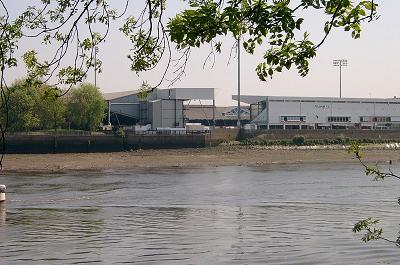 Craven Cottage, Home of Fulham FC
Craven Cottage, Home of Fulham FC
The original Craven Cottage was built for William Craven, the sixth Baron Craven in 1780. It was believed to have stood approximately where the centre of the pitch is now. The area at the time was heavily wooded and had previously been part of a hunting estate. There are many different claims of famous people who lived at the cottage, in fact so many that they all could not possibly have lived there. The cottage had one of those mysterious fires in 1888, and the land lay unused for another six years before Fulham Football Club started to develop it into a football ground.
Craven Cottage witnessed the fastest hat-trick ever scored in league football. On December 26th 1963 Graham Leggat scored three goals within three minutes as Fulham romped home 10-1 against Ipswich Town. As any regular Fulham fans will tell you, not a lot has happened since.
The approach to Putney Bridge is lined with boathouses owned by various rowing clubs. There are bits of boats everywhere. Ropes, oars, wetsuits, trailers and all sorts of boating paraphernalia are all over the place. Road, pathway, slipway and jetty all morph into one and I pick my way through the obstacle course. Almost all of the way from Shepperton the pathway has benefited from tree cover and with few exceptions the immediate surroundings had a rural feel to them, even though suburbia was visible only a short way off. The rest of the journey is going to be very different
< Previous Page | Next Page >